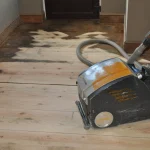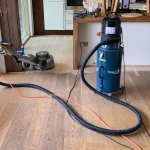The Importance of Dust-Free Floor Sanding: Health Risks and Safety Measures
Understanding the Health Risks of Wood Dust
Recently, Terry Guilford was consulted about the dangers of sanding a particular type of timber floor and why dust-free floor sanding is so important. The client had expressed concern that the wood used on the floor was known to cause health issues when sanded. Wood dust can cause several health problems, and while many are aware of respiratory issues, fewer know about other potential dangers. Here are the five main health risks associated with wood dust:
1. Lung Damage
Like asbestos, fine wood dust can linger in the air and be inhaled. Although not as deadly as asbestos, wood dust can cause small, irreversible wounds in the lungs, gradually reducing lung capacity.
2. Irritation
Wood dust can cause itching, sneezing, short-term breathing problems, skin flushing, and runny noses. Timbers such as Merbau, Ipe, and Iroko, commonly used in flooring, are known to cause these symptoms, though almost every type of wood can be an irritant to some degree.
3. Sensitivity
Repeated exposure to certain woods can increase sensitivity, causing worse reactions over time. Iroko is a known sensitizer, meaning it can cause heightened reactions with repeated contact.
4. Toxicity
Some woods are directly toxic, but fortunately, none of the highly toxic timbers are commonly used in flooring.
5. Cancer Risk
Exposure to dust from specific timbers, such as walnut and oak, can increase the risk of nasal cancer. These cancers can affect any part of the upper respiratory tract, including the throat.
Minimizing the Risk: The Importance of Dust-Free Floor Sanding
To mitigate these health risks, it is crucial to minimize airborne dust during floor sanding. Here are some effective methods:
Professional Floor Sanding Equipment

Using professional floor sanding equipment is essential for effective dust control. High-quality machines have better dust control than cheap-hire sanders. Smaller machines like edgers and random orbital sanders can be connected to extractors to improve dust collection. While dust control systems (DCS) are available for belt sanders, they add little to the performance of professional machines.
Air Movers and Ventilation
Strategically placed air movers in a room with open windows can help expel old, dusty air and replace it with fresh air. This is especially useful in larger areas with an exterior door and is often overlooked.
Personal Protection Equipment (PPE)
Wearing PPE such as masks or respirators is crucial, especially when using cheaper hire machines. Health experts recommend using PPE at all times during sanding. For those sensitive to specific timbers, a Tyvek suit and gloves provide additional protection.
Efficient Dust Control and Maintenance

Modern floor sanding equipment, when well-maintained, is highly efficient at controlling dust. However, the greatest exposure to dust occurs when emptying dust bags. If wearing protection during sanding is difficult, it is imperative to use it during this process.
Conclusion
Dust-free floor sanding is essential to protect against the health risks associated with wood dust. By using professional equipment, ensuring proper ventilation, and wearing appropriate PPE, the risks can be significantly reduced. For more information on the health risks of specific timbers, visit The Wood Database.
Embrace dust-free floor sanding practices to ensure a safer and healthier environment for everyone involved.